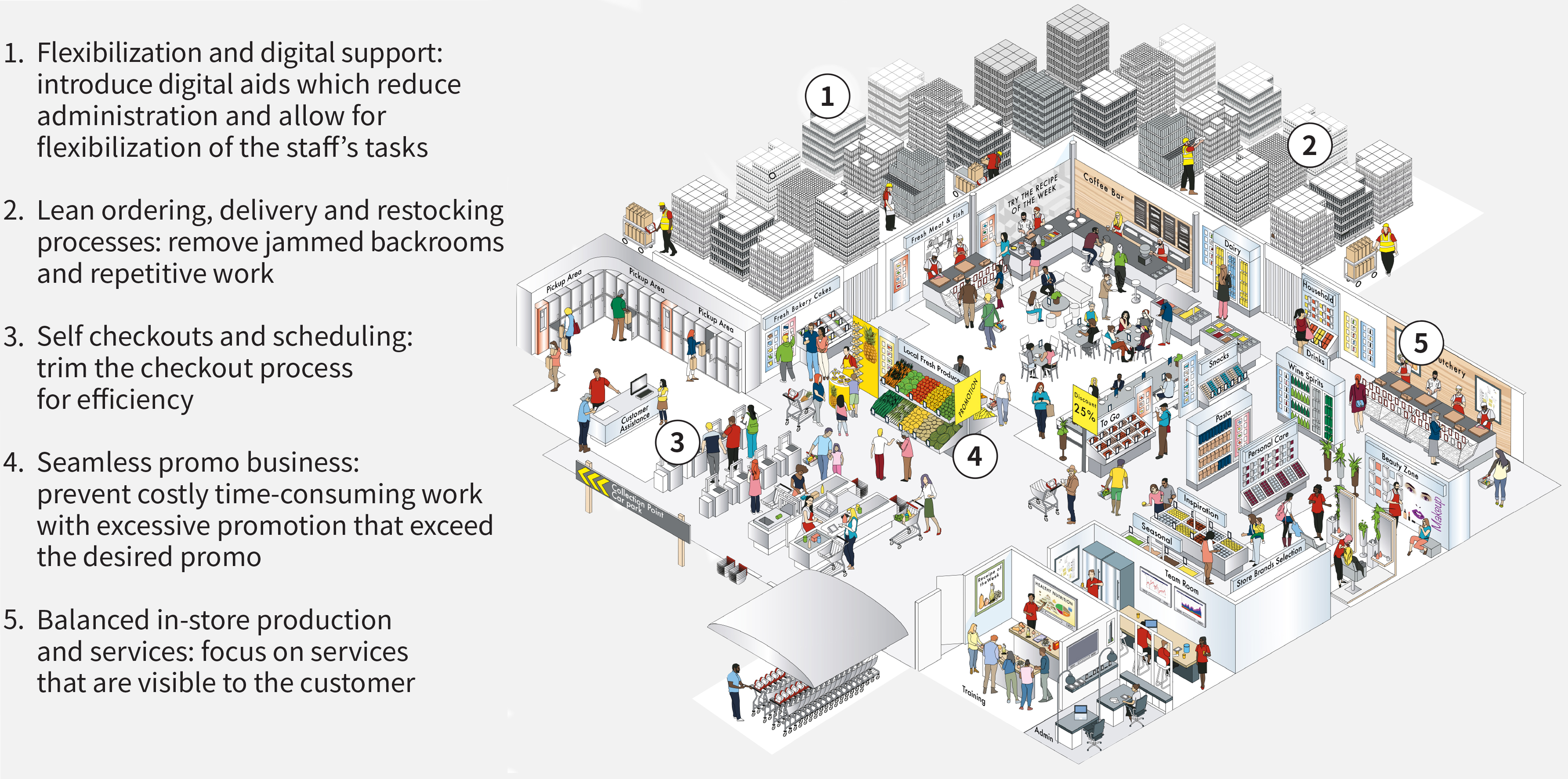The COVID-19 pandemic has provided some lessons for brick-and-mortar grocers. One of the most striking learnings is that there is plenty of scope to boost the productivity of store operations.
However, those productivity rises that were achieved during the crisis, have been mostly thanks to short-term increases in demand due to the pandemic. Some retailers have seen sustainable sale uplifts of 10 percent in stores without considerably more efforts. Apart from these encouraging short-term effects, grocers are rather facing creeping increases in the cost of their store operations year by year — a trend that started before the pandemic and will continue in the future. The trouble is, decision makers often lack clear links between their operational costs and the strategic decisions they make over product mix, the promo business, store operations, and other aspects of their operations.
Five Success Factors for Increased Productivity
To understand these links better, we carried out a large field study of seven European retailers and analyzed them through 100 key performance indicators in their store operations. We found five success factors of efficient retail operations, which can lead to increases in productivity of between 15 and 30 percent and make operations more resilient.
Most productive grocers do the following:
Lean ordering, delivery and restocking processes: They have largely automated the ordering process for all goods through sales-based ordering (SBO). Promo planning and ordering has been centralized, leaving limited local decision-making authority. Restocking is based on the principle that “every delivery fits the shelf”: Distribution centers provide sorted deliveries that reflect the layouts of individual stores and fit into the shelves without breaking them apart. Furthermore, Shelf-ready packaging and smart shelves are used for neat product presentation. This means goods only need to be handled once and don’t fill a store’s back rooms.
Seamless promo business: They have optimized their supply chains for just-in-time, ready-to-use promotion deliveries. Accurate central planning and KPI-driven category management ensure that few residuals are left over after promo weeks. Those that remain are dealt with through an effective process.
Balanced in-store production and services: They know which local production steps and services add value to their business, so they make deliberate compromises by ramping up and down services and staffing over the course of the day and the week. Local processes are restricted to customer-facing activities, such as running the bakery and the meat counter. Digital production-planning tools reduce the time spent on items produced in-store, while ensuring that quality standards are maintained.
Self checkouts and scheduling: They have implemented self-checkouts and optimized product packaging to boost scanning rates. Demand during the day can be forecasted based on models, so the cash desks are only opened at busy times and closed when traffic is quiet. In addition, flexible processes allow desks to be opened and closed in case of sudden rises or falls in customer numbers.
Flexible work and digital support: They use task-based labor-scheduling tools to calculate the expected staffing requirements in each store and plan shifts accordingly. The administration of shifts and tasks for each member of staff is made easier by intuitive, digitized tools for communication and productivity.

The Challenges For Productivity Improvement in Stores
To figure out which of these levers to focus on, grocers need to see the connections between their strategies and their costs. However, most don’t have enough information on the underlying drivers of workforce productivity and inefficiency. Some, in contrast, have gathered meticulous process descriptions and time evaluations from their workforces in an effort to understand — and thus mitigate — the challenges. But these reports are often too detailed and thus fail to pinpoint the main causes of inefficiencies. So, in both cases, decision makers lack clear links between the costs of retail operations and their strategic business decisions. That means they miss the key levers to significantly reduce costs and improve margins.
Retailers that want to make their costs more transparent can start with a three-step approach:
- Generate an understanding of the hours taken by the various operations in their stores
- Compare their operations with those outlined in the five success factors of productive grocers
- Identify gaps in operations, which will typically include central functions and sales, and address them
The disturbances caused by the COVID-19 pandemic offer a great chance for all grocers to challenge their store operations structures. We encourage them all to leverage this crisis and pave the way now for a step-change in productivity.
